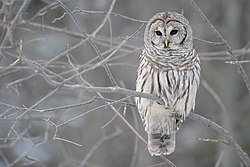Barred owl
The barred owl is a large owl commonly found in eastern North America.
| Barred owl | |
|---|---|

| |
| Conservation status | |
| Scientific classification | |
| Kingdom: | |
| Phylum: | |
| Class: | |
| Order: | |
| Family: | |
| Genus: | |
| Binomial name | |
| Strix varia Barton, 1799
| |
Description
The barred owl grow 43 to 61 centimeters (17 to 21 in) with a wingspan of 102 to 127 centimeters (40 to 50 in) at full length. The average male weigh 630 grams (22 oz) and female weigh 800 grams (28 oz). It has a round head with dark brown eyes while most owls in the eastern United States have yellow eyes. The barred owl lives about 10 to 12 years in the wild.[1]
Habitat
The barred owl lives in the woods across the eastern United States, southern Canada and Alaska. They sometimes migrate to Central America in the winter.[1][2] The great horned owl is the only predator of the barred owl.[1]
Reproduction
The barred owl makes nests on tree limbs and are usually near ponds or lakes. They may use nests that have been left by other animals. They can lay 1 to 5 eggs. Eggs hatch in 28 days and the young begin to fly 42 days later.[1]
Diet
The barred owl eats rabbits, squirrels, bats, snakes, and small insects.[2] They are able to find food from a far distance from its great hearing sense. They can also hunt fish.[1]
Barred Owl Media
Although previously considered a subspecies of barred owl, the fulvous owl is now considered a distinct species.
Some subspecies such as S. v. georgica from Florida differ from northern barred owls by their darker brown streaks and, more noticeably, their bare toes.
A barred owl in Ontario
A juvenile barred owl peers out in the verdant forests of Washington, where the species is an "invasive" recent invader.
Barred owl bathing in Brett Woods, Fairfield CT US
A barred owl consuming a mole (possibly a coast mole) in Washington.
References
| Wikimedia Commons has media related to Lua error in Module:Commons_link at line 62: attempt to index field 'wikibase' (a nil value).. |
- ↑ 1.0 1.1 1.2 1.3 1.4 Corbett, Lori; Denny Rogers (2008). The illustrated owl: Barn, Barred, & Great Horned: the ultimate reference guide for bird lovers, woodcarvers, and artists. The Denny Rogers Visual Reference series (illustrated ed.). Fox Chapel Publishing. pp. 84/5. ISBN 978-1565233133.
- ↑ 2.0 2.1 "Barred Owl". National Geographic Society. 2006. Retrieved 2010-11-27.









